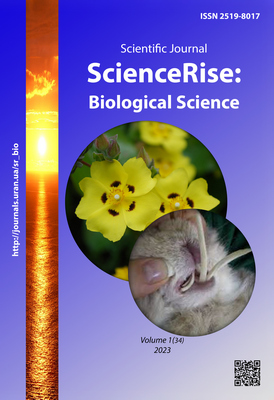Some biological, behavioral and social aspects of the perfumery use in the Ukrainian population sample (Part 2. Education level associations)
DOI:
https://doi.org/10.15587/2519-8025.2023.277216Keywords:
Perfumery, Ukraine, perfumery selection factors, education level, war, lipstick effectAbstract
The aim. The study represents a continuation of the previous one, and provide various aspects related to the use of perfumery, which can be characterized by certain associations with the education level of Ukrainian consumers. Factors that have direct or indirect biological and medical significance and, accordingly, may have a potential impact on the safety of the perfume products use by humans, were selected for the analysis.
Materials and methods. The analysis included information about 124 individuals living in Ukraine. The respondents answered the questions of the questionnaire developed regarding some aspects of the perfumery use. The Pearson chi-squared (χ2) test was used to analyze the relationships between qualitative characteristics.
Results and discussion. Most of the studied aspects related to the perfumes use demonstrate associations, caused by the dependence of the education level on age. The analysis revealed that individuals with any education most often (about half of the cases or more) choose a perfume based on its scent. The study showed that the majority of respondents believe that the price of a perfume depends on a combination of factors, namely the composition of the products, the brand and the cost of the packaging. More than 80 % of people, regardless of the education level, believe that the persistence of a perfume is definitely a sign of quality. The most common opinion among people of all education levels was that non-original perfumes can have a more negative effect on people's health than original products. The "lipstick effect" in relation to perfume products (demand for items of "affordable luxury" in times of economic crises and wars) was observed.
Conclusions. The study supplemented the previously found associations of age and some biological and behavioral aspects of perfume use among the population of Ukraine with data on the presence or absence of such associations in relation to the education level
References
- McGann, J. P. (2017). Poor human olfaction is a 19th-century myth. Science, 356 (6338). doi: https://doi.org/10.1126/science.aam7263
- Borg, C., Oosterwijk, T. A., Lisy, D., Boesveldt, S., de Jong, P. J. (2019). The influence of olfactory disgust on (Genital) sexual arousal in men. PLOS ONE, 14 (2), e0213059. doi: https://doi.org/10.1371/journal.pone.0213059
- von Wuthenau, K., Segelke, T., Kuschnereit, A., Fischer, M. (2021). Glass authentication: Laser ablation-inductively coupled plasma mass spectrometry (LA-ICP-MS) for origin discrimination of glass bottles. Talanta, 235, 122686. doi: https://doi.org/10.1016/j.talanta.2021.122686
- Filiptsova, O., Bashura, O., Naboka, O., Kran, O., Almakaiev, M., Kukhtenko, H. et al. (2022). Some biological, behavioral and social aspects of the perfumery use in the Ukrainian population sample (part 1. age associations). ScienceRise: Biological Science, 4 (33), 18–26. doi: https://doi.org/10.15587/2519-8025.2022.271043
- Rodrigues, A. E., Nogueira, I., Faria, R. P. V. (2021). Perfume and Flavor Engineering: A Chemical Engineering Perspective. Molecules, 26 (11), 3095. doi: https://doi.org/10.3390/molecules26113095
- Ncube, E. N., Steenkamp, L., Dubery, I. A. (2020). Ambrafuran (AmbroxTM) Synthesis from Natural Plant Product Precursors. Molecules, 25(17), 3851. doi: https://doi.org/10.3390/molecules25173851
- Yang, S., Tian, H., Sun, B., Liu, Y., Hao, Y., Lv, Y. (2016). One-pot synthesis of (−)-Ambrox. Scientific Reports, 6 (1). doi: https://doi.org/10.1038/srep32650
- Stepanyuk, A., Kirschning, A. (2019). Synthetic terpenoids in the world of fragrances: Iso E Super®is the showcase. Beilstein Journal of Organic Chemistry, 15, 2590–2602. doi: https://doi.org/10.3762/bjoc.15.252
- Gomes, C. L., de Lima, A. C. A., Loiola, A. R., da Silva, A. B. R., Cândido, M. C. L., Nascimento, R. F. (2016). Multivariate Classification of Original and Fake Perfumes by Ion Analysis and Ethanol Content. Journal of Forensic Sciences, 61 (4), 1074–1079. doi: https://doi.org/10.1111/1556-4029.13070
- Hananeh, W., Ghbari, F., Rukibat, R., Zghoul, M., Ismail, Z. (2021). Effects of fake and original perfumes on the presence, numbers, and distribution of mast cells in selected tissues in rats. Open Veterinary Journal, 11 (2), 277. doi: https://doi.org/10.5455/ovj.2021.v11.i2.11
- Noiesen, E., Munk, M. D., Larsen, K., Johansen, J. D., Agner, T. (2007). Difficulties in avoiding exposure to allergens in cosmetics. Contact Dermatitis, 57 (2), 105–109. doi: https://doi.org/10.1111/j.1600-0536.2007.01170.x
- Bahl, A., Garza, H. D. L., Lam, C., Vashi, N. A. (2022). The lipstick effect during COVID-19 lockdown. Clinics in Dermatology, 40 (3), 299–302. doi: https://doi.org/10.1016/j.clindermatol.2021.11.002
- Hill, S. E., Rodeheffer, C. D., Griskevicius, V., Durante, K., White, A. E. (2012). Boosting beauty in an economic decline: Mating, spending, and the lipstick effect. Journal of Personality and Social Psychology, 103 (2), 275–291. doi: https://doi.org/10.1037/a0028657
- Netchaeva, E., Rees, M. (2016). Strategically Stunning. Psychological Science, 27 (8), 1157–1168. doi: https://doi.org/10.1177/0956797616654677
Downloads
Published
How to Cite
Issue
Section
License
Copyright (c) 2023 Olga Filiptsova, Olga Naboka, Svitlana Bobro, Olexander Bashura, Yuliia Osypenko

This work is licensed under a Creative Commons Attribution 4.0 International License.
Our journal abides by the Creative Commons CC BY copyright rights and permissions for open access journals.
Authors, who are published in this journal, agree to the following conditions:
1. The authors reserve the right to authorship of the work and pass the first publication right of this work to the journal under the terms of a Creative Commons CC BY, which allows others to freely distribute the published research with the obligatory reference to the authors of the original work and the first publication of the work in this journal.
2. The authors have the right to conclude separate supplement agreements that relate to non-exclusive work distribution in the form in which it has been published by the journal (for example, to upload the work to the online storage of the journal or publish it as part of a monograph), provided that the reference to the first publication of the work in this journal is included.









